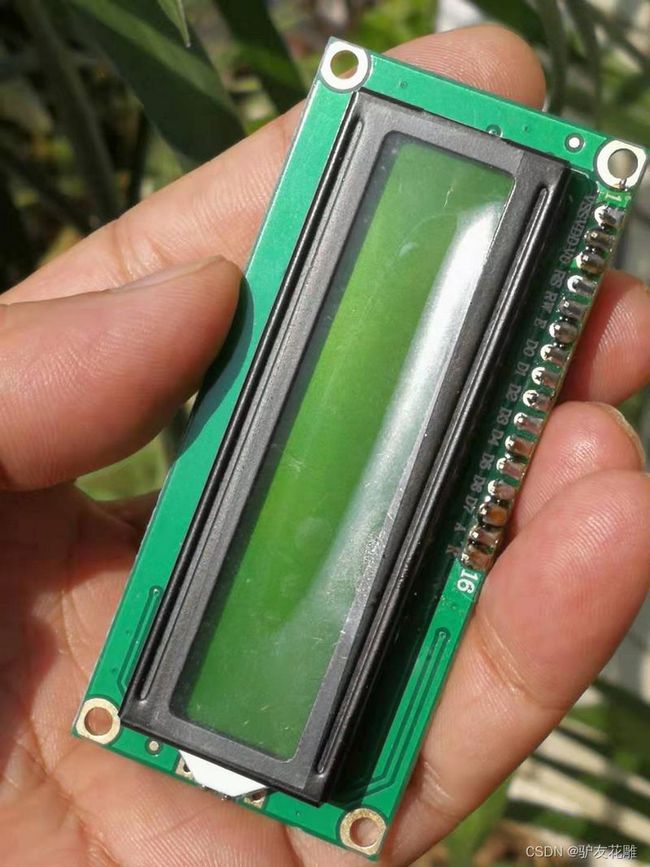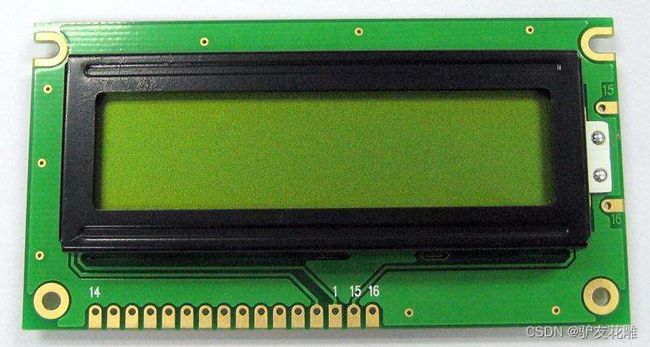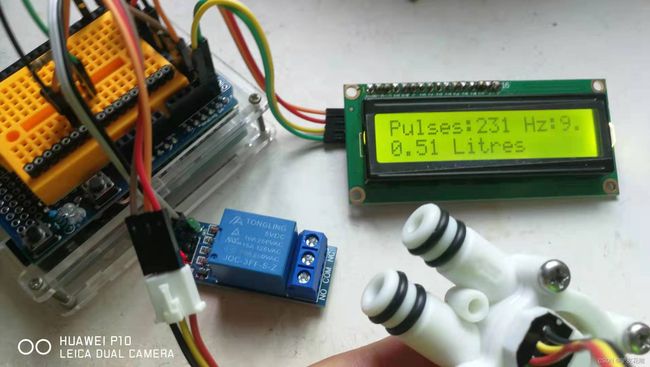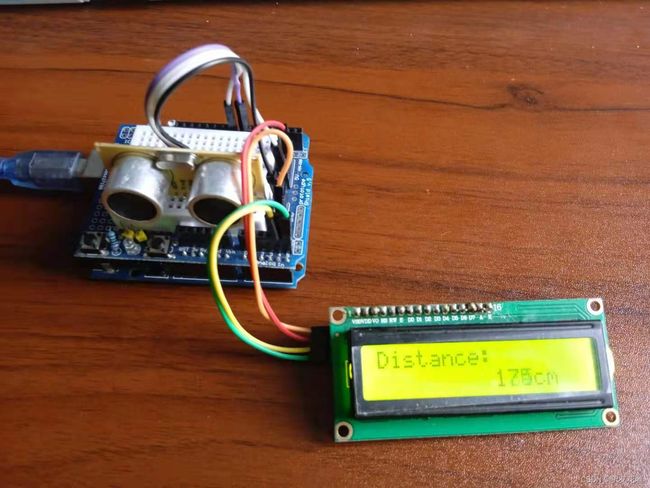【雕爷学编程】Arduino动手做(85)---LCD1602液晶屏模块4
37款传感器与执行器的提法,在网络上广泛流传,其实Arduino能够兼容的传感器模块肯定是不止这37种的。鉴于本人手头积累了一些传感器和执行器模块,依照实践出真知(一定要动手做)的理念,以学习和交流为目的,这里准备逐一动手尝试系列实验,不管成功(程序走通)与否,都会记录下来—小小的进步或是搞不掂的问题,希望能够抛砖引玉。
【Arduino】168种传感器模块系列实验(资料代码+仿真编程+图形编程)
实验八十五:LCD1602液晶显示屏1602A模块 蓝屏黄绿屏灰屏5V 3.3V焊排针 IIC/I2C
也叫1602字符型液晶,它是一种专门用来显示字母、数字、符号等的点阵型液晶模块。它由若干个5X7或者5X11等点阵字符位组成,每个点阵字符位都可以显示一个字符,每位之间有一个点距的间隔,每行之间也有间隔,起到了字符间距和行间距的作用,正因为如此所以它不能很好地显示图形(用自定义CGRAM,显示效果也不好)。1602LCD是指显示的内容为16X2,即可以显示两行,每行16个字符液晶模块(显示字符和数字)。市面上字符液晶大多数是基于HD44780液晶芯片的,控制原理是完全相同的,因此基于HD44780写的控制程序可以很方便地应用于市面上大部分的字符型液晶。

IC/I2C接口LCD1602转接板
控制板IO口只有20个,加些传感器、SD卡啥的,继电器等模块多了,IO口就不够用了,原来的1602屏至少需要7个IO口才能驱动起来,这个模块可以帮你省5个IO口。
参数
1.供电电压:+5V
2.支持I2C协议
3.具有背光灯,和对比度调节电位器
4.4线输出更简单
5.设备地址:0x27
【Arduino】168种传感器模块系列实验(资料代码+仿真编程+图形编程)
实验八十八: LCD1602A液晶屏5V显示模块(IIC/I2C接口)
项目二十:循环显示常用的键码
实验开源代码
/*
【Arduino】168种传感器模块系列实验(资料代码+仿真编程+图形编程)
实验八十八: LCD1602A液晶屏5V显示模块(IIC/I2C接口)
项目二十:循环显示常用的键码
Arduino------LCD1602
5V-------------VCC
GND-----------GND
A4-----------SDA IIC 数据线
A5-----------SCL IIC 时钟线
*/
#include 【Arduino】168种传感器模块系列实验(资料代码+仿真编程+图形编程)
实验八十八: LCD1602A液晶屏5V显示模块(IIC/I2C接口)
项目二十:循环显示常用的键码
实验场景图
【Arduino】168种传感器模块系列实验(资料代码+仿真编程+图形编程)
实验九十一: 1号霍尔水流量传感器 直饮机流量监控模块
项目十:用LCD1602A屏显示水流量传感器输出
实验开源代码
/*
【Arduino】168种传感器模块系列实验(资料代码+仿真编程+图形编程)
实验九十一: 1号霍尔水流量传感器 直饮机流量监控模块
项目十:用LCD1602A屏显示水流量传感器输出
实验接线:Uno D2接流量传感器OUT
Arduino------LCD1602
5V-------------VCC
GND-----------GND
A4-----------SDA IIC 数据线
A5-----------SCL IIC 时钟线
*/
#include 【Arduino】168种传感器模块系列实验(资料代码+仿真编程+图形编程)
实验九十一: 1号霍尔水流量传感器 直饮机流量监控模块
项目十:用LCD1602A屏显示水流量传感器输出
实验场景图
【Arduino】168种传感器模块系列实验(资料代码+仿真编程+图形编程) 实验八十八: LCD1602A液晶屏5V显示模块(IIC/I2C接口)
项目二十一:水流量传感器、5V继电器模块和LCD1602 I2C模块
实验接线:Uno D2接流量传感器OUT,继电器接D4
Arduino------LCD1602
5V-------------VCC
GND-----------GND
A4-----------SDA IIC 数据线
A5-----------SCL IIC 时钟线
实验开源代码
/*
【Arduino】168种传感器模块系列实验(资料代码+仿真编程+图形编程)
实验八十八: LCD1602A液晶屏5V显示模块(IIC/I2C接口)
项目二十一:水流量传感器、5V继电器模块和LCD1602 I2C模块
实验接线:Uno D2接流量传感器OUT,继电器接D4
Arduino------LCD1602
5V-------------VCC
GND-----------GND
A4-----------SDA IIC 数据线
A5-----------SCL IIC 时钟线
*/
#include 【Arduino】168种传感器模块系列实验(资料代码+仿真编程+图形编程)
实验八十八: LCD1602A液晶屏5V显示模块(IIC/I2C接口)
项目二十一:水流量传感器、5V继电器模块和LCD1602 I2C模块
实验接线:Uno D2接流量传感器OUT,继电器接D4
实验串口返回情况
【Arduino】168种传感器模块系列实验(资料代码+仿真编程+图形编程)
实验八十八: LCD1602A液晶屏5V显示模块(IIC/I2C接口)
项目二十一:水流量传感器、5V继电器模块和LCD1602 I2C模块
实验接线:Uno D2接流量传感器OUT,继电器接D4
实验场景图
【Arduino】168种传感器模块系列实验(资料代码+仿真编程+图形编程)
实验八十八: LCD1602A液晶屏5V显示模块(IIC/I2C接口)
项目二十二:LCD1602显示超声波测距(单位cm)
实验接线:Uno D7接HC-SR04模块TRIG,D8接ECHO
Arduino------LCD1602
5V-------------VCC
GND-----------GND
A4-----------SDA IIC 数据线
A5-----------SCL IIC 时钟线
实验开源代码
/*
【Arduino】168种传感器模块系列实验(资料代码+仿真编程+图形编程)
实验八十八: LCD1602A液晶屏5V显示模块(IIC/I2C接口)
项目二十二:LCD1602显示超声波测距(单位cm)
实验接线:Uno D7接HC-SR04模块TRIG,D8接ECHO
Arduino------LCD1602
5V-------------VCC
GND-----------GND
A4-----------SDA IIC 数据线
A5-----------SCL IIC 时钟线
*/
#include Arduino实验场景图








